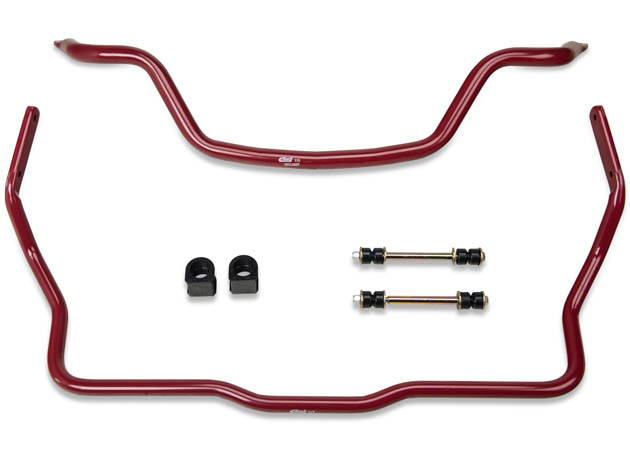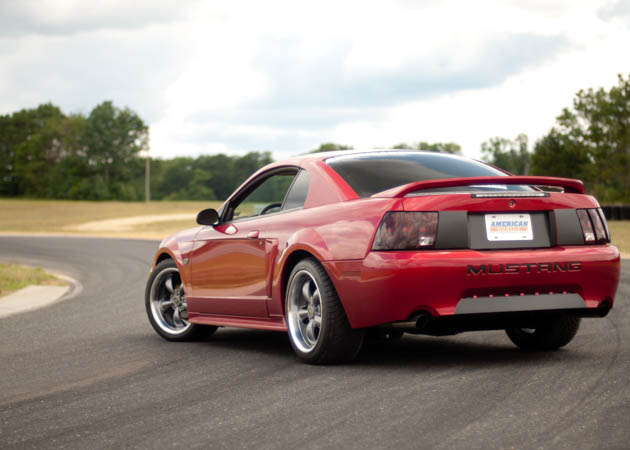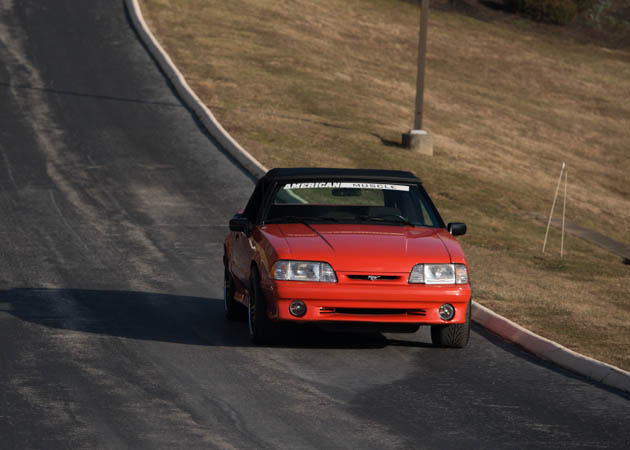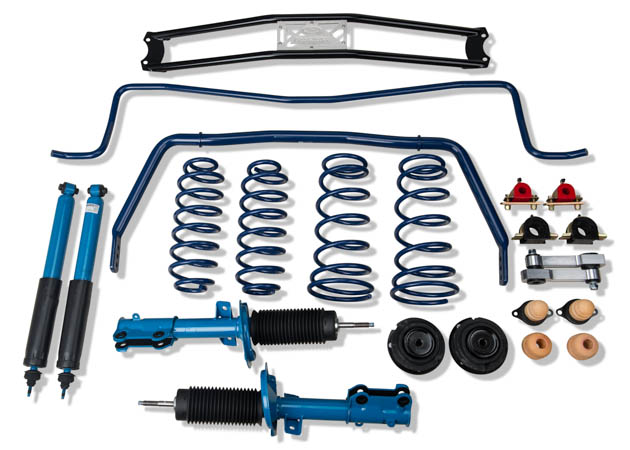If you're looking to build a track day Mustang, a sway bar kit will help you tackle corners and reduce times. You can also easily pair sway bar with other suspension mods to fine tune your track build.
Shop Mustang Sway Bars
If you're looking for a slight boost in handling a sway bar will help stiffen up your Mustang's body so you can tackle tighter corners.
Shop Sway Bars
What Do Mustang Sway Bars Do?
- Sway bars reduce your Mustang’s body roll while tackling corners
- Aftermarket sway bars are sometimes adjustable
- Front sway bars link the struts together to keep your Mustang level in a corner
- Rear sway bars connect to the rear axles and help reduce understeer
- Too stiff of a bar will make driving on bumpy roads uncomfortable, much like how a stiffer suspension would be more jostling
Sway bars are a key component to making your Mustang handle well. Sometimes referred to as anti-roll bars, they control body roll when turning or making sharp maneuvers. As the body leans, grip transfers from one side of the car to the other. While some weight transfer can be beneficial, too much can adversely affect handling. Keeping the car flat through the turns provides more even grip, helping to neutralize excessive oversteer. Too much body lean will apply more traction to the wheels receiving the weight. This can unload the differential and cause oversteer.
Sway bars are a torsional spring; they work by tying both sides of the suspension together, forcing both struts to move in tandem. By forcing one side to raise or lower the same amount as its partner, you can reduce body roll. As a bar gets stiffer, the stronger the spring becomes, and the stronger spring means less body roll. Another benefit to upgrading sway bars is tuning understeer and oversteer to your preference.
Mustangs have two sway bars, one in the front and one in the back. The factory sway bars are non-adjustable. Sway bars are an excellent complement to a set of control arms in terms of overall handling prowess. Drag racers often remove their front sway bar to get improved weight transfer while dropping a few pounds off the nose as well.
Front Sway Bar
On a 2005-2014 Mustang, the front sway bar works by linking both the front struts together, and on a 79-04 Mustang the front bar works by connecting to the lower control arm. It is also attached to the frame of the vehicle, giving it a place to rotate. Since sway bars are torsional springs, installing a stiffer front sway bar will force the struts or lower control arms to raise and lower with each other at a very similar rate. As one side of the car drops down, the other side will rise because of the increased spring rate of the bar, keeping the body level. By increasing the stiffness of the front bar, you may also increase the amount of understeer that the vehicle experiences. This can be equalized by increasing the stiffness of the rear bar.
Rear Sway Bar
A rear sway bar is installed by bolting drop links to the chassis of the car, then bolting both ends of the sway bar to the rear axle. Since the rear axle on 79-14 Mustangs is a solid axle, you don’t need to worry about the wheels moving at different rates, but the stiffer bar will help keep the rear of the car from rolling. As one side of the car drops down, the bar will pull down on the other end link, preventing roll. If you are experiencing too much understeer on your Mustang, you can install a stiffer rear bar. The increased spring rate on the rear will help take some of the cornering load off the front car, allowing it to turn more sharply with less understeer.
On a Mustang, the rear sway bar should always be a smaller diameter since the car is rear-wheel drive. A bigger sway bar in the front increases lateral and motive traction in the rear and in cases where the rear sway bar is the bigger of the two, this causes an increase in front tire traction.
How Do End Links Work?
In addition to upgrading the anti-roll bars, the aftermarket offers various types of end-links which attach to the anti-roll bar and the lower control arm. Adjustable end-links offer further control over the tuning of the suspension and are an important addition to lowered vehicles as they help correct the altered geometry of the suspension.
Adjusting the preload of the bar will tailor the handling for whatever street/track setup you are looking for. They’re also usually stronger and lighter than the factory pieces, and some offer greasable fittings which (with regular maintenance) reduce noise, vibration, and harshness (NVH).
Downsides to Larger Sway Bars
By adding more bar stiffness, you will increase the amount of jarring felt by uneven roads, since the bumps will be transferred more easily from one wheel to the other. This is not usually noticeable when running an adjustable bar on its lower settings, or by getting a more mild non-adjustable bar. When increasing bar stiffness too much, a vehicle may also lift a tire off the road. On a solid axle car like 79-14 Mustangs, the inside front tire would be prone to lifting when cornering, since it is being lifted up to match the level of the outside cornering tire. This is generally not an issue unless you are cornering very aggressively, with an incredibly stiff bar.
Should I Get Sway Bars for my Mustang?
If you are trying to make your Mustang into a corner carving monster, or just want a street toy with better balance and handling, sway bars are definitely a must. If you find the factory suspension to be sloppy and unresponsive, a set of sway bars when used with lowering springs and a good set of shocks and struts, will give you crisp and responsive car. If extra noise, vibration, or harshness are a big deal for you, get a set of good street/track bars. They will be mild enough that the jarring effects of stiffer sway bars will be very minimal, while the handling benefits will remain. If a little extra road feel isn’t a problem for you, then a set of stiffer bars, or the stiffer settings on an adjustable set of sway bars will be perfect for your Mustang!
Adjusting a Sway Bar and its Impact
Most aftermarket sway bars have three holes on the ends where the sway bar end links fasten to. The furthest adjustment hole away from the sway bar will cause the sway bar to rotate less than holes which sit closer inward to the sway bar. The furthest adjustment hole away from the sway bar will provide a softer or "looser" transition. The closest adjustment hole toward the sway bar will provide a stiffer or hard transition.
Soft Front Bar:
- Increases front traction of the car while decreasing the rear traction
- Increases the roll of the car
- Understeers the vehicle
Stiff Front Bar
- Decreases front traction of the car while increasing the rear traction
- Decreases the roll of the car
- Oversteers the vehicle
Soft Rear Bar
- Increases car roll
- Decreases front traction while increasing rear traction
Stiff Rear Bar
- Decreases car roll
- Increases front traction while decreasing rear traction
- Increases Steering sensitivity during high speed cornering
Fitment includes: 1979, 1980, 1981, 1982, 1983, 1984, 1985, 1986, 1987, 1988, 1989, 1990, 1991, 1992, 1993, 1994, 1995, 1996, 1997, 1998, 1999, 2000, 2001, 2002, 2003, 2004, 2005, 2006, 2007, 2008, 2009, 2010, 2011, 2012, 2013, 2014, 2015, 2016, 2017, 2018, 2019, GT, V6, Cobra, ShelbyGT500, Mach1, Bullitt, Boss, LX, SVO, EcoBoost, ShelbyGT350





